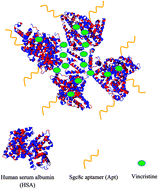Targeted delivery of vincristine to T-cell acute lymphoblastic leukemia cells using an aptamer-modified albumin conjugate
Abstract
Clinical application of vincristine in treatment of cancer is restricted because of its poor solubility and neuropathy. Targeted delivery of cytotoxic drugs could improve their therapeutic efficacy and reduce their severe side effects. Biocompatibility and high accumulation of human serum albumin nanoparticles (HSA) in tumors make this substance an ideal candidate for biomedical usage. Here, a Vincristine–HSA–Sgc8c aptamer (Apt) complex was designed and assessed for the treatment of Molt-4 cells (human acute lymphoblastic leukemia T-cell, target). Vincristine–HSA conjugate and Vincristine–HSA–Apt complex formations were analyzed by particle size analyzer, transmission electron microscopy (TEM) and gel retardation assay. Internalization of the Vincristine–HSA–FAM (3′-fluorescein)-labeled Apt complex into Molt-4 (target) and U266 cells (B lymphocyte human myeloma, nontarget) was monitored by confocal imaging and flow cytometry analysis. For cell viability (MTT assay), both cell lines were treated with vincristine, Vincristine–HSA conjugate, HSA–Apt conjugate and Vincristine–HSA–Apt complex. Vincristine was efficiently loaded (8.5%) into HSA. The results of confocal imaging and flow cytometry analysis indicated that the Vincristine–HSA–FAM-labeled Apt complex was effectively internalized into target cells (Molt-4) but not into nontarget cells (U266). The results of MTT assay also confirmed the internalization data. The Vincristine–HSA–Apt complex had less cytotoxicity in U266 cells compared to vincristine alone and Vincristine–HSA conjugate. In conclusion, the developed drug delivery system acquired properties of high drug loading, high cancer cell accumulation and cancer cell targeting.


 Please wait while we load your content...
Please wait while we load your content...